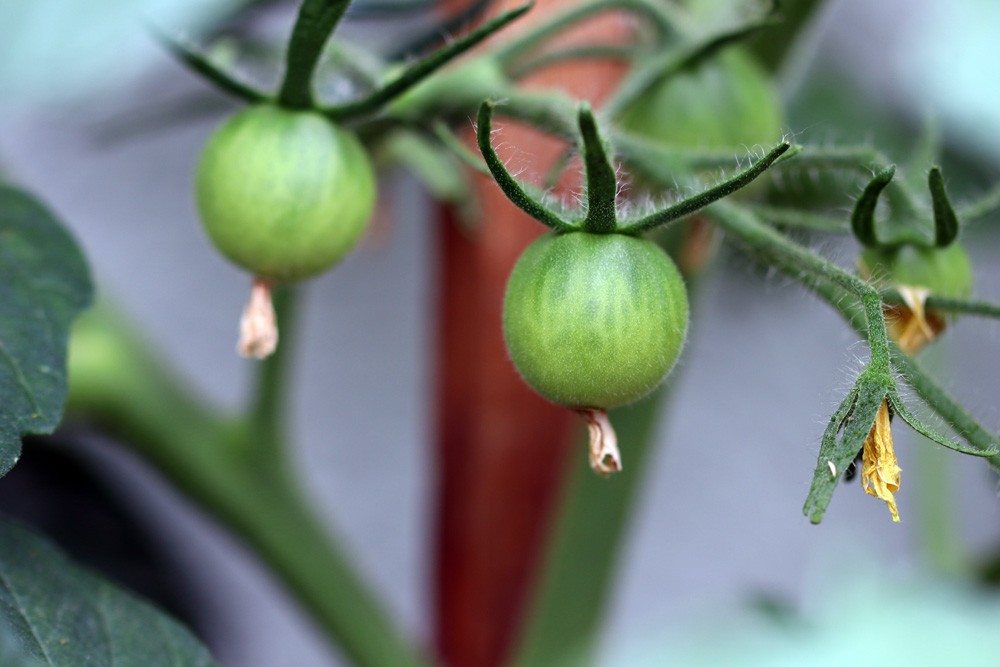Last updated on October 23rd, 2023 at 08:30 pm
Growing tomatoes yourself and harvesting the sweet, red fruits fresh from the bush is great fun. However, the plants are very sensitive to errors in care, too dark locations or too cool and humid weather. Sometimes they respond to less than optimal conditions by refusing to flower. Without flowers, however, there is no fruit, so here is a summary of the most common causes of failure to flower, along with tips on how to get the plant to bloom after all.
Contents
Flowering time depending on the variety
- Patience with late varieties and beef tomatoes -.
In many cases, there are no external causes for late blooms, instead you just simply got a late variety. Basically, very early, early, medium-late and late varieties are distinguished from each other, all of which differ greatly in development. Thus, the early tomatoes grow faster, set flowers and also fruits earlier – on average, you can pick them already between 50 and 70 days after sowing.
Medium-late and late varieties take much longer to flower set and fruit ripening, here you can wait until harvest between 70 and 85 days. Late varieties include, for example, beef and oxheart tomatoes, and lettuce and stake tomatoes sometimes take a bit longer as well. If you are unsure, take a look at the variety description. There the harvest time is indicated.
Causes of lack of flowering

But not always unwillingness of the tomato plant to bloom is due to the late variety, sometimes behind it are errors in care or the selected location is unsuitable for tomato culture. Take a close look at your tomatoes and growing conditions to filter out the possible cause. Occasionally, there is not a single cause to blame for the lack of blooms. Instead, there are several factors at play, but they can usually be easily remedied.
- wrong location
- weather and temperature
- lack of nutrients / little growth
- sowing too late / tomatoes still too small
- Fertilization with too much nitrogen / tomatoes “shoot up”.
- plant shock / lack of hardening off
- unsuitable soil / substrate
- Forgetting to prune
Options in case of missing blossoms
If the tomato plant feels well, it will also develop flowers. The following measures will help it to do so.
Transplant tomato
Tomato plants are sun worshippers: The optimal location is in full sun, so that the shrub gets at least eight hours of sun a day. If, on the other hand, it is placed in the shade, it will be too dark and will not even produce flowers. In this case, you should move the plant to a more suitable, brighter place.
But be careful: tomatoes are very sensitive not only to cool weather, they also do not tolerate excessive heat. Therefore, choose a full sun, but airy location. This should not necessarily be directly in front of a bright house wall in southern orientation, as it often comes to a heat accumulation. If the tomatoes in the appropriate location are still shaded over midday, they will soon begin to bloom.
Optimal fertilization for tomatoes
Tomatoes belong to the highly nutritious plants that require a lot of nutrients. Nevertheless, a balanced composition of fertilizers is necessary. Both a lack of nutrients and overfertilization can cause the plants not to bloom. Incorrect / insufficient fertilization makes the tomato plant grow little, so it remains small and puny for a long time, as well as develops few side shoots. However, many varieties of tomatoes set flowers only after a certain height of growth – usually around one meter.

Conversely, if the plant is heavily fertilized, especially with nitrogen, it invests too much energy in its growth and less in flowering. Such specimens grow very large very quickly, they “shoot into the weeds”. Supply your tomatoes best with a special tomato fertilizer, which contains all the nutrients in the appropriate composition, or fertilize them with organic materials. With compost, manure (especially horse and cattle manure!), horn shavings and nettle liquid manure overfertilization is practically impossible, because the nutrients are released slowly and sequentially, so the plant is not suddenly flooded.
Cover tomato plants
Rainy weather, cool temperatures: this can also cause tomatoes do not want to bloom. Cultivate them best under glass, such as in a tomato greenhouse or cold frame, in case of unsuitable weather or sharp temperature fluctuations. If you plant the bushes in the garden, harden them off slowly at first: the planting shock caused by a sudden transplant without any warning can also lead to a failure to bloom. Outdoor tomatoes also thrive better if you cover them. This measure also helps to avoid the common late blight.
Tomato plants bloom – without fruit
For a tomato fruit to develop, the stigma – which is the female part of the flower – must be fertilized by suitable pollen. Naturally, this is done by insects and by wind, but weather and temperature conditions can cause disturbances and thus lower fruit set. Tomatoes are basically self-fertile, i.e. the flowers fertilize themselves with their own pollen. When the buds open, pollen from the stamens – the male parts of the flower – reaches the stigma.

If the air is very dry, the pollen does not stick to the stigma; if, on the other hand, it is too humid, the anthers do not release pollen. If it is too cool, there is only a small amount of fruit set; excessive heat also damages the pollen. The optimum temperature for pollination is 18 to 26 °C – if it is colder or warmer, you will have to move the plant accordingly and help with pollination. To do this, gently shake the inflorescence, but you can also shake the support rods. This works best if you pollinate the tomatoes at noon.


